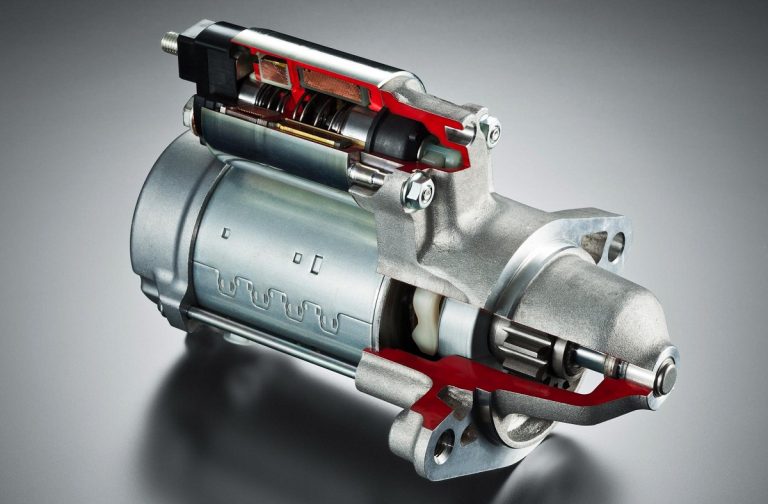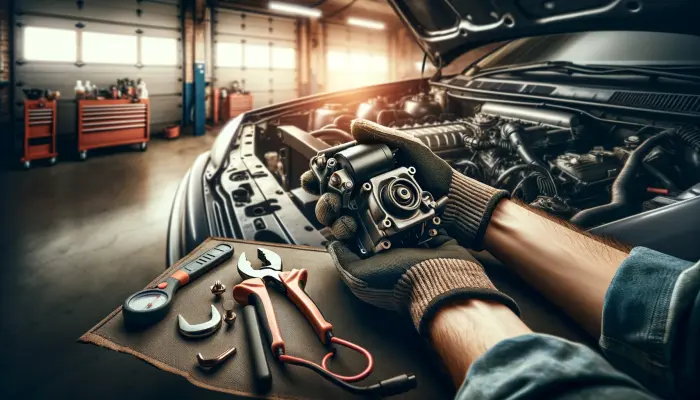A car's starter is an electromechanical device designed to start the engine. Its operation is based on rotating the crankshaft through the flywheel until a certain speed is reached, after which the engine starts and operates independently. The starter is powered by the car's battery. The electrical starting current is supplied to the starter immediately after the driver turns the ignition key.
History of Starters
The first electric starter was installed in a car in 1896 in England. The first electric starter in the USA was patented in 1903, and in 1911, Charles Kettering invented and patented an improved version. Starters were first installed in the Cadillac Model Thirty in 1912 and have since become standard in cars.
Comparison of Starters
Starters can vary depending on the type of engine (diesel or gasoline) and the type of vehicle (passenger or commercial). Differences can include size, power, and design of the device.
Technological Innovations
With the development of the automotive industry, starters have also undergone changes. For example, modern starters include start-stop systems that contribute to fuel savings and emission reduction.
Key Components of a Starter

Each starter, regardless of its unique design features, consists of the following main components:
- Armature with an embedded magnetic core and a set of collector lamellas.
- Brackets with carbon brushes that enhance power and supply voltage to the lamellas.
- Solenoid, which transmits energy from the ignition system and pushes out the freewheeling clutch.
- Starter body (electric motor), a steel cylinder that houses the magnetic cores and windings.
- Bendix with gears, which engages with the flywheel, causing it to rotate.
The structure of the starter also includes the stator, front and rear bushings, return spring, planetary gearbox, collector, locking ring, and other parts. Starters installed in cars with automatic transmission, such as an Audi with an automatic transmission, may be equipped with additional windings that prevent the engine from starting if the selector lever is in drive mode.
Operating Process
The starter is activated as soon as the driver turns the ignition to the "Start" mode. During this process:
- Voltage is supplied to the solenoid, and the magnetic coil moves the armature.
- The Bendix with gears is brought to the flywheel's toothed crown, and the contact plates on the starter motor close.
- The armature begins to rotate under the influence of the starting current passing through its winding, in the magnetic field of the stator.
- As soon as the engine starts, the driver releases the ignition key, which stops the control voltage to the solenoid. As a result, the contact plates open, and the Bendix with gears returns to its original position under the action of the return spring.
Common Faults The most common starter failures are related to the jamming or breakdown of the traction relay, damage to windings, wear of the Bendix gears and rollers, and brush wear. Wear of bearings and bushings, as well as sticking of contact plates, can also occur.
Usually, repairing a starter is considered ineffective, and it is preferable to purchase a new unit.
Maintenance and Diagnostic
Tips Tips for maintaining and diagnosing a starter:
- Regular Inspection: Regularly inspect the starter and its connections. Ensure all cables and terminals are clean and securely fastened.
- Listen to the Starter Sounds: Pay attention to the sounds the starter makes when starting the engine. Any unusual noises are typically a sign of problems.
- Check the Electrical System: If the starter is not working, check the battery and electrical connections. A low battery charge or a poor connection can lead to starting problems.
- Wear of Components: Pay attention to the wear of the starter brushes and the condition of the Bendix gear. These parts are most prone to wear.
- Professional Diagnosis: If you are unsure of the cause of the problem, seek professional diagnosis. Some starter problems require specialized knowledge and equipment for their identification and resolution.
- Replacing the Starter: In some cases, it may be more practical to replace the starter rather than try to repair it, especially if it is heavily worn or damaged.
In conclusion, the starter is a key component of a car, ensuring a reliable engine start. Proper maintenance and timely diagnosis help prevent many problems associated with this device. Regular inspection and attention to signals indicating potential malfunctions ensure the longevity and efficiency of the starter's operation. In the event of serious malfunctions or significant wear, it is recommended to consult specialists for repair or replacement of the device, to ensure the safety and reliability of your vehicle.
